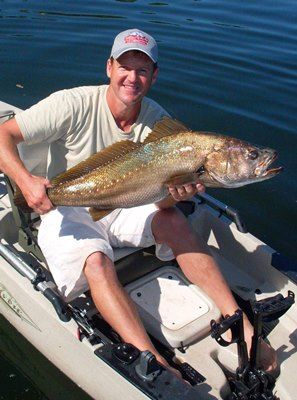Latest News
Balancing Fishing and Conservation: It’s Not One Or The Other
Tuesday, 24 March 2015
By Rob Paxevanos
Rob Paxevanos is the Author of Australian Fishing Basics and the Host of Fishing Australia on the WIN, NBN and GO Networks.
The federal government’s review of marine parks and sanctuaries is focused on the impact of marine sanctuaries on fishing. But, if it is going to informed decisions it will have to examine the evidence of how conservation and fishing is already working hand-in-hand in many parts of Australia, delivering benefits to people and the environment.
Being the host of a national fishing television program I get bombarded with info from both sides of the Marine Park Debate. I also use, read and hear much about the less debated but equally as important fishing havens-a fish management system in NSW that some argue are a better option than marine parks.
However Fishing Havens and Marine Parks both aim to protect our aquatic environments and the inhabitants so why all the fuss about which one is best? I’m going to give my opinion on the main things I have learned about both these management options and try and paint the fairest picture I can.
I was first dragged into the marine park debate in about 2005 when the Batemans Marine Park proposal was brought to my attention. At the time this is where I did much of my local fishing and weekly fishing reports. The first message I was presented with by more senior angling journalists, some anglers, and political/business leaders (hidden agendas or not) was that we were going to lose the right to fish some areas within the new marine park. These no fishing zones were dubbed ‘Sanctuary Zones’...and they fast became a dirty word in angling circles.
Like many Australians I enjoyed the freedom of being able to fish almost anywhere (in the saltwater at least) and I was offended by the possibility of closures. I stepped onto the ‘anti-marine park’ bandwagon with press articles and attendances at anti marine park meetings and rallies. I was a key component in driving the message that we were being told where we can fish by non local city slickers that were anti fishing.
In the process, our message spread far and wide to the point where I started to notice some tourists started to take their holidays elsewhere. These were not well informed anglers who knew the details of what was happening, rather they were those who were hearing the broad noise we were making about the marine park stuffing up our ability to wet a line in the Batemans region.
So, as it turns out tackle and fishing related tourism operators (eg accom, charter boats, etc) started to suffer from our spreading of the anti marine park message. It may have turned out that if marine parks were stopped this would’ve changed, but in the interim something else happened.
Being a key ‘mouth piece’ for ‘no Batemans marine park’ I was approached by local Tourism to consider looking the possibility of helping anglers accept the looming the marine park if...wait for it...commercial netting was banned in the Clyde River. The Clyde River is one of the largest unregulated (undammed) rivers on the NSW coast, it’s catchment is massive and pristine and forms a major fish breeding and recruitment zone ...it just had one problem...nets were dragging the heart out of the sea bed and fish stocks. There was gleaming light on the horizon if this could be stopped.
Now the various planned restrictions on commercial fishing in Marine parks were not a new theme, for example commercial trawling was always going to be banned inside 3 Nautical miles of the coastline (which later proved to work extremely well for recreational angling catch rates and associated tourism), but banning commercial nets in the Clyde was the oil that fixed the squeaky wheel.
It was a big decision for me to accept the Marine Park, and an even bigger task to go back to the general public and explain why I changed my mind. But no matter which way I looked it, the fought for version of the proposed marine park would, as a whole, benefit anglers. I still believe this to be the case to this day.
Of course no management system is perfect, and fisheries by nature are dynamic and need to be managed with ongoing tweaks to suit, but one thing’s for certain the fishing in Batemans Marine Park now goes from strength to strength each year. It’s a joy to be able to catch better numbers of prized fish...flathead, snapper and jewfish are just a few examples that spring to mind, and even the slow growing gummy sharks are starting to make a comeback in the last couple of years.
I even fronted a TV Campaign which was along the lines of ‘Eurobodalla’ is open to recreational fishing, and you won’t fish all in all lifetime. But while most were sure reduced commercial fishing would work for recreational anglers and tourism, the problem still remained with sanctuary zones, which at the time were to make up approximately 20% of the Marine Park. Where do the powers that be place these ‘no fishing zones’...this was the hardest task for them, the devil was in the detail.
Personally I am able to easily travel to a wide variety of spots outside sanctuary zones, others are not so mobile, or have had sanctuary zones placed where they had fished for generations. One very unfortunate man had a sanctuary zone placed in his back yard, a place he had just brought after working for all of his life!
Good thing is, as a whole the benefits outweigh the negatives, and these days if a new marine park is coming in, or an old one is up for review my advice to anglers is typically along the lines of; don’t go in holus bolus ‘NO Marine Park’ you probably aren’t going to be able to stop it (we couldn’t) and why would you there are massive benefits like restrictions on destructive commercial netting.
The focus for anglers concerned about sanctuary zones should be working together with local like minded groups and authorities to help put sanctuary zones away from popular, easily accessible or prevailing weather protected fishing spots so that less anglers are affected (and often more fish are protected in remote spots too). It really is up to local anglers to get together and discuss their specific local area and needs and present/push for these requirements.
Now what about the various Fishing Havens in NSW? Such as Tuross, Durras, etc. As the name suggests these are places (usually estuaries) which are managed primarily to suit recreational anglers so things like commercial netting are banned. I haven’t had any specific involvement with the setting up of any particular Haven, but I have fished many, and I can say they definitely work in an anglers favour. Less nets equals better habitat, more fish and happier anglers. The management of these must remain dynamic for best effect , but having ‘angler representatives’ on the committee or at least having a strong say in what happens is very effective for us anglers.
So anglers are understandably gunning for more havens, for example in addition to Botany Bay the Australian Recreational Fishing Foundation ( ARFF) has Sydney Harbour and the Hawkesbury River in their sights. While the possibility of Port Phillip Bay on Melbourne’s doorstep becoming a Rec Fishing Haven has already entered the state political arena.
Meanwhile the Marine Parks Authority is gunning for more Marine Parks, sometimes in the same areas! One of the big differences is that havens have very little if any sanctuary zones outside the ones that have typically been in place for eons, while one of the big sticking points with MP’s is where the sanctuary zones should be placed.
Despite anti marine park groups arguing otherwise it is worth noting that sanctuary zones now have some science to show that sanctuary zones do work with some species. There is a web film up at www.saveourmarinelife.org.au/theseaandme which shows experts communicating the summaries of their studies. For example massively increases in size and numbers of Crayfish numbers at Tasmania’s Maria Island. Increases in numbers of brood sized Coral Trout inside sanctuary zones on Great Barrier Reef sanctuary zones are another great example. Both crays and coral trout are highly sought after target species by both recreational and commercial anglers, so to see them building is numbers in sanctuary zones is a really good thing.
Better still the clip talks about the ‘spill over effect’ which proves fish spawned in sanctuary zones are travelling to areas outside the sanctuary zones. This is really good news and it is changing the tide on how people perceive sanctuary zones in a positive way. Reputable rec anglers, commercial anglers, dive operators, fishing charter operators and other user groups in this video are interviewed and they have an important and positive perspective on marine park sanctuary zones.
Personally I have long had an underlying belief that sanctuary zones in moderation, and in the right place give fish some peace from humans allowing them to build in numbers and size, behave naturally and breed in peace...that is unquestionably good. Giving up fishing spots just takes a little more time to digest and appreciate the benefits.
And amongst all this let’s not forget what myself and many angling journalists fall back on when the marine park debate and politics become too much...we focus on educating anglers on sustainable practices-this is as important as ever.
But back on topic and while in some ways it seems like a race because once an area is a Fishing Haven it ‘may’ be harder for it to be managed as a marine park and vice versa, perhaps this is not the question. Fisheries Management (Havens) and Marine Parks might be most effective if they combine forces rather than fight against each other, and we are starting to see this...after all both parties have the same objectives.
I have yet to discuss commercial anglers’ views on the whole shebang, and there is plenty of fiercely debated details on this front too, but in brief I often hear those in it for the long term, especially commercial fishing families that have spanned generations, are all for seeing their livelihood managed as best as is possible. Like rec anglers, commercial anglers have had to accept change, and will have to be ready to accept more. Where change is looming much debate will still be needed to see everyone gets a piece of the ‘fish’ pie...but good things happen from spirited discussion.
Mother nature also weighs in on the debate...she’ll throw in a massive increase in some fish numbers from a successful spawning of a species that we don’t even understand the basics of. But I can’t use this argument against no sanctuary zones any more...when it happens it’s a bonus, sanctuary zones are just more likely to make it happen.
I must also note that habitat protection is another critical component in managing fish stocks...fish can’t breed properly when habitat is polluted or destroyed, sanctuary zone or not! We all need to keep our eye on the big polluters, and both Marine Parks and Fishing Havens will only help keep in check big companies who have no real intent or plan on real ‘long term’ environment protection.
To conclude with in layman’s terms no fisheries (haven) or zoning (marine park) management system is perfect, and more rules can be a pain for governments to manage and a pain for users to digest and adhere to, but with a building population we may have little choice if we are to both use and conserve our precious marine resources as best we can.
Tags Marine Parks Sanctuaries



